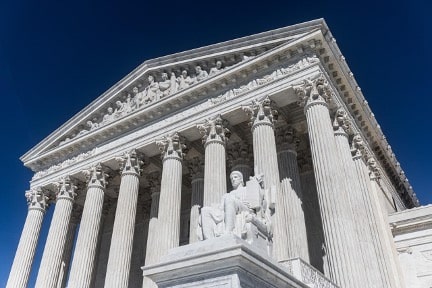The Supreme Court of the United States recently struck down nearly all forms of affirmative action by colleges and universities as unlawful under the equal protection clause of the Fourteenth Amendment. While court-watchers expected this move, it still caused shockwaves, killing off a program that many have seen as the cornerstone of a plan to offer equal opportunities to all Americans and others have viewed as college discrimination.
The Background Facts
Students for Fair Admissions (SFFA) sued two colleges, Harvard and the University of North Carolina (UNC). SFFA is a non-profit group formed to fight affirmative action plans. SFFA then recruited students from the colleges as members. In court, there was a kerfuffle over whether they were a genuine membership organization that had the organizational standing to sue. Chief Justice Roberts stated that even if they didn’t have members at one time, they do have members now and so can sue.
In this case, all the prior courts — trial and appeals — said the affirmative action plans were legal and permissible.
What Is Affirmative Action?
Affirmative action covers several programs for schools, work, and more that give boosts to people who were underrepresented or unrepresented before. Barriers can be based on race, gender, or other criteria. In the U.S., affirmative action began with the civil rights movement in the 1960s and focused originally on Black people. As it is understood today, affirmative action covers several racial and ethnic minorities as well as women. According to a Swedish study, all these groups have seen gains in their salaries and positive externalities in minority communities between 1964 and 2006. Since 1978 when the Bakke decision (below) first limited affirmative action, the programs have been fading away because of Supreme Court rulings.
Harvard’s Affirmative Action Plan
Each year, Harvard builds a class of 1,600 students from over 60,000 applicants, nearly all of whom are excellent students and outstanding young people.
To do this, a first reader ranks the students from 1 to 6 (1 is best) in six categories: academic, extracurricular, athletic, school support, personal, and overall. Overall combines the five others. This first reader takes race into account. The files then go to a subcommittee that oversees a geographic area. They make recommendations to the full committee. The subcommittee can consider race.
The files next go to the whole committee (40 members). It reviews the regional committee’s recommendations and looks at the relative breakdown by race as compared to other years. The focus is to make sure that the school doesn’t have a big drop in minority admissions from the previous year.
They reveal the racial identities of students before “the lop,” which cuts a few more students out to reach the final class. They place all potential cuts on a list and consider them for legacy status, recruited athlete status, financial aid eligibility, and race. Race is a “determinative tip” for all Black and Hispanic applicants.
UNC’s Affirmative Action Plan
UNC gets 43,500 applications annually for a class of 4,200. Readers look over these applications and consider race and ethnicity as one factor. They rate each applicant numerically on the categories of academic, extracurricular, personal, and essay. They then provide a written recommendation on admission and may record a plus where race is significant. A review committee, which can also consider race, approves or rejects these decisions.
The Cases: Students for Fair Admissions v. Harvard and Students for Fair Admissions vs. UNC
Chief Justice Roberts gave the opinion of the Court. The Court held that the admissions systems used by Harvard and UNC were not lawful under the equal protection clause of the Fourteenth Amendment. In other words, affirmative action is mostly over in the United States.
Behind him, the court splintered into three concurrences and two dissents. This shows a court that agreed upon dismantling affirmative action but could not agree on the reason they should dismantle it.
The Fourteenth Amendment
The Fourteenth Amendment was passed by Congress and ratified by the states shortly after the Civil War. It made “all persons born or naturalized in the United States” citizens and barred states from denying “equal protection of the laws” to “any person within its jurisdiction.” It thus mandated the absolute equality of all citizens and extended that protection to non-citizens as well.
Education and Discrimination
These high ideals fell fast, and state-mandated segregation lasted over a century. The Supreme Court played a role in endorsing separate but equal in the case of Plessy v. Fergusson. Even those who tried to do well under this divided system could not do so. Separate cannot be equal.
When the Supreme Court decided Brown v. Board of Education, they started to invalidate all racial discrimination set by law. They also set the goal that public education must be available equally to all. The Court followed Brown by striking down segregation and race-based state action in many areas. In this, Roberts said, the Court was holding up the “core purpose” of the equal protection clause: eliminating all racial discrimination.
Is Racial Discrimination Ever Okay?
If there has to be racial discrimination, it has to be for an excellent reason. This reason is the two-step examination called strict scrutiny found in the Grutter case (below). First, the racial classification must “further compelling government interests.” Second, the use of race must be “narrowly tailored” or necessary.
The Court has found two compelling interests. One is fixing specific instances of past discrimination. The other is stopping a race-based prison riot.
University Admissions and Race
Regents of the University of California v. Bakke looked at a set-aside program where 16 out of 100 seats at the UC Davis Medical School were reserved for minority students. That case showed a deeply fractured court with six different opinions (much like the case before us now). Without having a majority, Justice Powell’s opinion from the middle became the law.
The court struck down three of four justifications for affirmative action as insufficiently compelling.
- Reducing the historic deficit of minorities in medical schools
- Remedying the effects of social discrimination
- Increasing the number of doctors working in underserved areas
The fourth interest was compelling: the educational benefits that come from having a diverse student population.
Even to fulfill that, Powell said in Bakkethat any sort of racial or ethnic distinction was inherently suspect. Quotas, set-asides, and using race to hurt an individual were bad. Race could only act as a plus.
Another case, Grutter v. Bollinger, looked at admissions to the University of Michigan Law School. It set clear limits on what schools could do with affirmative action. First, schools must make sure they are not stereotyping. Second, if they use race as a plus for one group, they cannot use it against other groups.
The case also said that the program must have an ending date or measurable conditions under which it would end. The court expected that “25 years from now the use of racial preferences will no longer be necessary to further the interest approved today.” Interestingly, that was 20 years ago.
Deciding the Case
The admissions systems at Harvard and UNC failed the strict scrutiny test because they didn’t meet the narrow restrictions put forth in Grutter. Their compelling interests are not something a court can measure, and therefore cannot go up for judicial review.
The admissions programs also do not link the means they use and their goals. The racial categories don’t make much sense. Grouping all Asian students together, when this large group is quite diverse, is problematic. So is using “Hispanic”, a term tied to language, not race.
The schools cannot use the equal protection clause as a negative or a stereotype. A First Circuit case found that considering race has caused an 11.1 % drop in the number of Asian Americans at Harvard. Roberts stated his belief that admissions is a zero-sum game and that if you let in more of one race, you have to let in less of another.
Grutter called for a logical endpoint to affirmative action. The table below clearly shows minority student numbers slowly rising at Harvard under affirmative action.
Share of students admitted to Harvard by race
| African-American Share of Class | Hispanic Share of Class | Asian-American Share of Class | |
| Class of 2009 | 11% | 8% | 18% |
| Class of 2010 | 10% | 10% | 18% |
| Class of 2011 | 10% | 10% | 19% |
| Class of 2012 | 10% | 9% | 19% |
| Class of 2013 | 10% | 11% | 17% |
| Class of 2014 | 11% | 9% | 20% |
| Class of 2015 | 12% | 11% | 19% |
| Class of 2016 | 10% | 9% | 20% |
| Class of 2017 | 11% | 10% | 20% |
| Class of 2018 | 12% | 12% | 19% |
The Court said there was no reason to believe that Harvard acting in good faith would end affirmative action any time soon unless ordered to.
UNC hoped to have its enrollment of black students be in line with the percentage of black people in the state of North Carolina and viewed that as an endpoint. The Court disagreed, stating that UNC had to treat individuals individually. UNC listed some qualitative standards which the Court said were too difficult to measure. Finally, UNC claimed that if Grutter said 25 years, they should get at least 5 more years. The Court (basically) said they were being silly.
The Holding
From all this, the court said that the Harvard and UNC admissions programs failed the test of the equal protection clause. It stopped short of totally prohibiting the use of race in admissions decisions. Schools can use race in evaluating application essays or other parts of the total package. But affirmative action as we have known it is over.
The Other Opinions
Prior affirmative action cases have splintered the court, and this one did as well. The cases came down 6-2 and 6-3 against affirmative action, but these numbers hide a lot of disagreement. The reasons for dismantling such a long-standing and important program matter.
The Concurrences
Justice Thomas concurred with the results that the court reached, but not with the logic the Court used to get there. He offered his own originalist interpretation where the Constitution, Thirteenth, and Fourteenth Amendments always meant all men were created equal. They just got off track at several points. He also found it insulting when people say that Black people only got where they are today because of affirmative action.
Justice Gorsuch concurred with the results. He believed that the court could have reached its decision under Title VI instead of going back to the Constitution. His argument used the principle that if one can decide a case under a law, it is better to do that than use the Constitution.
Justice Kavanaugh concurred as well. He wanted to state that he felt the 25-year time limit was firm and he would have decided the case there.
The Dissents
Justice Sotomayor wrote a thorough dissent, disagreeing on every point with the Court’s opinion. She gave a history of Black education, speaking of how affirmative action was needed then and now. She criticized Chief Justices Roberts for quoting and using dissents. Looking at the Harvard and UNC admissions programs, she called them narrowly tailored. She even noted that admissions rates for Asian Americans have been rising everywhere, despite historic and present discrimination against the group.
Justice Jackson wanted to expand on Justice Sotomayor’s opinion to explain the history and reality of race in America. She recused herself from the Harvard case. However, she went into great detail about UNC’s history and how hypothetical students might fare under the admissions systems.
Asian-Americans, Affirmative Action, and the Supreme Court’s Ruling
Before the Court decided this case, the Pew Research Center surveyed Asian Americans concerning affirmative action. The group had mixed responses. Of those surveyed who had heard of affirmative action (74% of the respondents), 53% believed that it was a good thing. But when asked whether race and ethnicity should play a role in college admissions, only 21% said yes. Other groups surveyed displayed the same pattern.
Indians are most likely to say affirmative action is a good thing at 60% (followed by Filipino and Japanese). Chinese were least likely at 45% (followed by Vietnamese and Korean). Divisions struck along party lines with 64% of Asian Democrats favoring affirmative action. Republicans only had 32% favoring (and 39% opposed). Women supported it more than men. Younger people supported it more than older people, except for the 65+ age group, which supported it more.
However, when given a list of potential factors for college admissions, only 21% said race or ethnicity should be a factor in college admissions. High school grades, standardized test scores, and community service all got over 70% support. At under 50%, athletic ability and family income come next. Then race and ethnicity, which is followed by gender and family connections.
All other races have this mixed result, but none to the extent seen among Asian Americans. When interviewed, Asian Americans saw benefits in employment from affirmative action, especially for Asian women. They also saw political benefits in getting people into top positions. Overall, they really just had mixed feelings about affirmative action.
After the Ruling
In the past, Asian students have been the objects of discrimination. They were cast as the “yellow peril” and put into camps during World War II. Since that time, they have morphed into the model minority, but are still targets of racist violence. Now they make up 22% of Harvard’s entering class and are the subject of two narratives. The first is that, with their high scores and grades, they will benefit from the removal of affirmative action.
This narrative held that the Court’s ruling will help Asian-American and white students and hurt others. A study found an immediate jump in enrollment for Asian and white students at the most selective schools after California banned affirmative action in 1996. However, over ten years all groups moved closer to parity. This pattern happened in other states, except the University of Florida enrolls far fewer Black students today. When they don’t admit minorities to the top universities, they enroll in larger numbers at the other universities in the state.
Kenny Xu, a D.C.-based writer, has written a book on the subject entitled An Inconvenient Minority: The Attack on Asian American Excellence and the Fight for Meritocracy. He claims to reveal discrimination at the nation’s most selective universities.
The second narrative is more complex. It splits Asians up into several smaller groups and claims that some will benefit while others will be hurt. Uncertainty follows this Supreme Court decision.
A study by the Georgetown University Center on Education and the Workforce found that Asians are not experiencing discrimination at the country’s 91 most selective schools. Their findings included that the percentage of Asian Americans admitted aligned with the percentage of Asian American applicants who were highly qualified. The study found that Asian Americans were more likely to apply to selective colleges than other groups and that if standardized tests were the only criteria, the percentage of Asian students would only increase by 2%.
Another analysis by College Rover and USA Today showed increasing numbers of Asian students at both Harvard and UNC, displayed in the table below.
| 2010 | 2021 | |
| Harvard | 14.1% | 18.3% |
| UNC | 5.8% | 12.6% |
| All US colleges | 6.7% | 6.1% |
Mixed Feelings
The New York Times interviewed several young Asian Americans, finding mixed reactions over the end of affirmative action. Regardless, they still fear that the application process at elite schools is biased against them. The students feel pressure to write about hardship in their essays, even though many of them had comfortable, middle-class lives. They fear that race-based admissions will just turn to class-based admissions.
Some Asian-American groups felt that the ruling used Asian Americans as a wedge to divide minorities and benefit whites. Others noted that some groups like Hawaiians and Pacific Islanders will have to go through more hoops to gain access to elite universities.
NPR investigated Ed Blum, the force behind many of the anti-affirmative action cases. They found that he looks for people to fit his narrative for each case. In the past, he found women to claim they weren’t getting into elite colleges. They said he used Asians as proxies for whites to say things he could not say about whites.
Some Asian Americans called the case a victory and celebrated. That feeling was most likely to come from the East Asian community. Southeast Asians were more likely to feel a sense of loss. The stereotypical image of the Asian immigrant we now have is of the individual who comes to this country, works hard, encourages their children to study hard, and everyone finds success. This stereotype pushes another, that of Asian high school students rushing from their after-school programs to fill seats at all the elite colleges.
In the California colleges that dropped affirmative action in 1998, Asians have done well. They and whites have increased their numbers at the competitive schools. Smaller Asian groups, like Filipinos, native Hawaiians, and Guamians have not fared as well.
No one is truly certain how the end of affirmative action will affect Asian-American students. The Supreme Court of the United States ended it but left a small space for it in the personal essay and letters of recommendation. Throughout this case, both sides have tossed around Asian Americans as symbols for their arguments.
Is your child thinking of applying to an elite college? Tell them to apply. We all have to wait and see what happens, but it looks like shifts in numbers will be small for Asian Americans even if the tempest over them today is large.
SOURCES:
20-1199 Students for Fair Admissions v. Harvard. (June 29, 2023). The Supreme Court of the United States. https://www.supremecourt.gov/opinions/22pdf/20-1199_hgdj.pdf
Balingit, Moriah. (July 1, 2023). “‘Invisible’: Some Asian Americans say admissions decision is no victory.” The Washington Post .https://www.washingtonpost.com/education/2023/07/01/asian-americans-affirmative-action/
Brown v. Board of Education of Topeka (1). (n.d.). Oyez. Retrieved July 11, 2023, from https://www.oyez.org/cases/1940-1955/347us483
Carapezza, Kirk. (July 22, 2021). “As Supreme Court Weighs Harvard Admissions Case, Two Asian Americans Speak Out And Allege Bias.” GBH News. https://www.wgbh.org/news/education/2021/07/22/as-supreme-court-weighs-harvard-admissions-case-two-asian-americans-speak-out-and-allege-bias
Chen, Janice Kai, and Daniel Wolfe. (June 29, 2023). “State affirmative action bans helped White, Asian students, hurt others.” The Washington Post. https://www.washingtonpost.com/education/2023/06/29/affirmative-action-banned-what-happens/
Dirks, Sandhya. (July 2, 2023). “Affirmative action divided Asian Americans and other people of color. Here’s how.” Weekend Edition Sunday. https://www.npr.org/2023/07/02/1183981097/affirmative-action-asian-americans-poc
Georgetown University Center on Education and the Workforce. (n.d.). “Selective Bias: Asian Americans, Test Scores, and Holistic Admissions.” https://cew.georgetown.edu/cew-reports/selectivebias/
Grutter v. Bollinger, 539 U.S. 306 (2003). https://supreme.justia.com/cases/federal/us/539/306/case.pdf
Hartocollis, Anemona. (July 8, 2023). “After the Affirmative Action Ruling, Asian Americans Ask What Happens Next.” The New York Times. https://www.nytimes.com/2023/07/08/us/affirmative-action-asian-american-students.html
History Channel Editors. (November 28, 2018). “Segregation in the United States.” The History Channel. https://www.history.com/topics/black-history/segregation-united-states
Holzer, Harry. 2007. “The economic impact of affirmative action in the US.” Swedish Economic Policy Review. https://www.government.se/contentassets/6310cf0f5c5049c6b0ee15d1cfc49b74/harry-holzer-the-economic-impact-of-affirmative-action-in-the-us
Jaschik, Scott. (July 18, 2021). “Study Questions Bias Against Asians in Admissions.” Inside Higher Ed. https://www.insidehighered.com/admissions/article/2021/07/19/study-questions-bias-against-asians-admissions
Johnson v. California, 543 U.S. 499. (2005). https://supreme.justia.com/cases/federal/us/543/03-636/index.pdf
Moges-Gerbi, Meron, Athena Jones, and Christina Maxouris. (July 3, 2023). “Lawsuit alleges Harvard gives preferential treatment to legacy admissions, who are ‘overwhelmingly’ White.” CNN. https://www.cnn.com/2023/07/03/us/harvard-college-legacy-admissions-lawsuit/index.html
Parents Involved in Community Schools v. Seattle School Dist. No. 1, 551 U.S. 701. (2007). https://supreme.justia.com/cases/federal/us/551/05-908/index.pdf
Plessy v. Ferguson, 163 U.S. 537 (1896). https://supreme.justia.com/cases/federal/us/163/537/#tab-opinion-1917401
Regents of the University of California v. Bakke. Oyez. Accessed July 11, 2023. https://www.oyez.org/cases/1979/76-811.
Ruiz, Neil G., Ziyao Tian and Jens Manuel Krogstad. (June 8, 2023). “Asian Americans Hold Mixed Views Around Affirmative Action: Most are skeptical of considering race and ethnicity in college admissions.” Pew Research Center. https://www.pewresearch.org/race-ethnicity/2023/06/08/asian-americans-hold-mixed-views-around-affirmative-action/
Students for Fair Admissions. “Help Us Eliminate Race and Ethnicity from College Admissions.” Accessed July 11, 2023.
U.S. Constitution. Amendment XIV.
Wong, Alia. (June 20, 2023). “Ahead of Supreme Court affirmative action case ruling: Do Harvard, UNC discriminate?” USA Today. https://www.usatoday.com/story/news/education/2023/06/20/harvard-unc-affirmative-action-case-claims-investigated/70329657007/
Yam, Kimmy and Sakshi Venkatraman. (June 29, 2023). “Some Asian Americans say affirmative action ruling used the group as ‘pawns’.” NBC News. https://www.nbcnews.com/news/asian-america/asian-americans-say-affirmative-action-ruling-used-pawns-rcna91861









